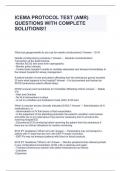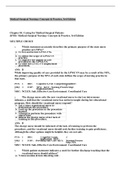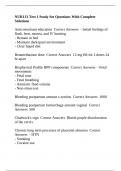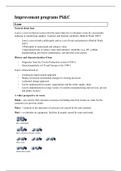International Strategy
Lecture 1
Globalisation
Learning objectives
1. Understand what is meant by the term globalisation
2. Recognise the main drivers of globalisation
3. Describe the changing nature of the global economy
What is globalisation ?
- The globalisation of markets
- Refers to the merging of historically distinct and separate national
markets into one huge global marketplace
- Falling barriers to cross-boarder trade and investments
- Global tastes
- Signi cant di erence between national markets
- Products that serve universal needs are global: oil
- Competitors may not change among nations
- The globalisation of production
- Sourcing goods to take advantage of di erences in cost & quality of
factors of production
- Factors of productions including labor, energy, land and capital
- Early outsourcing was con ned to manufacturing
- Modern communication technology has advance outsourcing
today for service activities
- Obstacles prevent optimal dispersion of activities:
fi ff fi ff
, - Formal & informal barriers to trade
- Barriers to foreign direct investment
- Transportation costs
- Political & economic risk
- Challenge of coordination globally dispersed supply chain
The emergence of global institutions
- Institutions needed to help manage, regulate, and police global
marketplace
- WTO
- IMF
- The world bank
- UN
- Standards are the guidelines that describes the best way of doing
something
- ISO
- Fairtrade
- Sustainable development goals
Drivers of globalisation: decline in trade and investment barriers
- 1920s to 1930s: many barriers to international trade and foreign direct
investment
- GATT lowered barriers: Uruguay round extended GATT and established
WTO
- Between 1960 and 2018 the value of the world economy increased 9.4
times, while the value of International goods increased 22.4 times
- Trade in goods & services and the value of foreign direct investment have
all been growing faster than world output
- More rms dispersing production process to di erent locations around
the globe
- Economies of the world’s nation-states are becoming more intertwined
- World has become signi cantly wealthier in the past two decades
fi fi ff
, Drivers of globalisation: role of technological change
- Communication
- Development of the microprocessor single most important innovation
since WW1
- Moore’s law predicts that the power of microprocessor technology
doubles and its cost of production falls in half every 18 months
- The internet
- More than half of the world’s population uses the internet
- Global e-commerce sales over $2.5 trillion
- The internet acts as an equaliser
- Transportation technology
- Commercial jets, super-freighters, and containerisation have all
«shrunk the globe»
- Implications of the globalisation of production
- Locating production in geographically separate locations has become
more economical
- Implications of the globalisation of markets
- Cultural distance has been reduced and has brought some
convergence of consumer tastes & preferences
The changing demographics of the global economy
- The changing world output & world trade picture
- 1960s: U.S accounted for 38.3% of world output
- 2018s: U.S accounted for 24% of world output
- This re ects the faster economic growth of several other economies,
particularly China
- China and BRIC countries growing more rapidly
- Developing nations may account for more than 60 percent of
world economic activity by 2025
- The changing foreign direct investment picture
fl
Lecture 1
Globalisation
Learning objectives
1. Understand what is meant by the term globalisation
2. Recognise the main drivers of globalisation
3. Describe the changing nature of the global economy
What is globalisation ?
- The globalisation of markets
- Refers to the merging of historically distinct and separate national
markets into one huge global marketplace
- Falling barriers to cross-boarder trade and investments
- Global tastes
- Signi cant di erence between national markets
- Products that serve universal needs are global: oil
- Competitors may not change among nations
- The globalisation of production
- Sourcing goods to take advantage of di erences in cost & quality of
factors of production
- Factors of productions including labor, energy, land and capital
- Early outsourcing was con ned to manufacturing
- Modern communication technology has advance outsourcing
today for service activities
- Obstacles prevent optimal dispersion of activities:
fi ff fi ff
, - Formal & informal barriers to trade
- Barriers to foreign direct investment
- Transportation costs
- Political & economic risk
- Challenge of coordination globally dispersed supply chain
The emergence of global institutions
- Institutions needed to help manage, regulate, and police global
marketplace
- WTO
- IMF
- The world bank
- UN
- Standards are the guidelines that describes the best way of doing
something
- ISO
- Fairtrade
- Sustainable development goals
Drivers of globalisation: decline in trade and investment barriers
- 1920s to 1930s: many barriers to international trade and foreign direct
investment
- GATT lowered barriers: Uruguay round extended GATT and established
WTO
- Between 1960 and 2018 the value of the world economy increased 9.4
times, while the value of International goods increased 22.4 times
- Trade in goods & services and the value of foreign direct investment have
all been growing faster than world output
- More rms dispersing production process to di erent locations around
the globe
- Economies of the world’s nation-states are becoming more intertwined
- World has become signi cantly wealthier in the past two decades
fi fi ff
, Drivers of globalisation: role of technological change
- Communication
- Development of the microprocessor single most important innovation
since WW1
- Moore’s law predicts that the power of microprocessor technology
doubles and its cost of production falls in half every 18 months
- The internet
- More than half of the world’s population uses the internet
- Global e-commerce sales over $2.5 trillion
- The internet acts as an equaliser
- Transportation technology
- Commercial jets, super-freighters, and containerisation have all
«shrunk the globe»
- Implications of the globalisation of production
- Locating production in geographically separate locations has become
more economical
- Implications of the globalisation of markets
- Cultural distance has been reduced and has brought some
convergence of consumer tastes & preferences
The changing demographics of the global economy
- The changing world output & world trade picture
- 1960s: U.S accounted for 38.3% of world output
- 2018s: U.S accounted for 24% of world output
- This re ects the faster economic growth of several other economies,
particularly China
- China and BRIC countries growing more rapidly
- Developing nations may account for more than 60 percent of
world economic activity by 2025
- The changing foreign direct investment picture
fl










